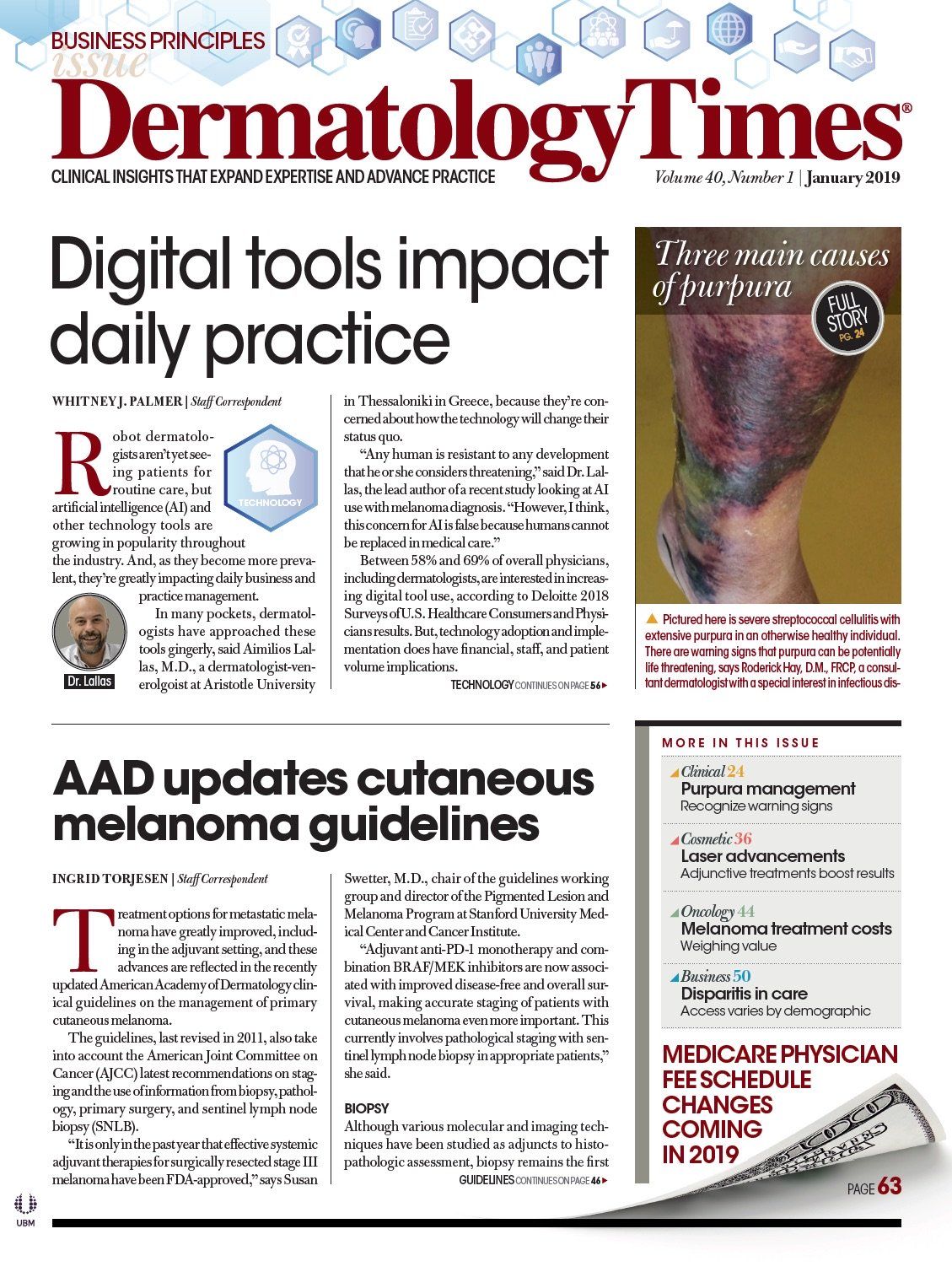- Case-Based Roundtable
- General Dermatology
- Eczema
- Chronic Hand Eczema
- Alopecia
- Aesthetics
- Vitiligo
- COVID-19
- Actinic Keratosis
- Precision Medicine and Biologics
- Rare Disease
- Wound Care
- Rosacea
- Psoriasis
- Psoriatic Arthritis
- Atopic Dermatitis
- Melasma
- NP and PA
- Skin Cancer
- Hidradenitis Suppurativa
- Drug Watch
- Pigmentary Disorders
- Acne
- Pediatric Dermatology
- Practice Management
- Prurigo Nodularis
- Buy-and-Bill
Publication
Article
Dermatology Times
Warning signs of life-threatening purpura
Author(s):
Do you know the warning signs of life threatening purpura? Dr. Roderick Hay outlines what you need to know about potentially life-threatening conditions involving purpura.
Dr. Roderick Hay

There are warning signs that purpura can be potentially life threatening, says Roderick Hay, D.M., FRCP, a consultant dermatologist with a special interest in infectious disease.
Purpura occurs when blood escapes from the vascular system into the skin. It can manifest in various ways from very small petechiae to large bruises, but despite its presentation, “they are all manifestations of the same problem. Although, the more most severely affected you are, the greater the leak is likely to be,” said Dr. Hay, of King’s College Hospital in London.
There are three main causes of purpura: Disorders of platelets, disorders of coagulation and vasculitis. These are not mutually exclusive, he explains, because if platelets and the factors involved in coagulation have been destroyed or incapacitated, coagulation is disrupted.
During a session on life threatening diseases in dermatology held at the European Academy of Dermatology and Venerology Congress last September in Paris, Dr. Hay outlined some potentially life-threatening conditions in which purpura is involved and which are often related to infections.
LIFE THREATENING CONDITIONS
The first of these is purpura fulminans, a rare and severe complication of meningococcal septicaemia which is caused by Neisseria meningitidis. Although far more common in tropical countries than in North America, when meningococcal septicaemia does occur, it carries a high mortality-largely because it is not recognized until it’s too late. The bacteria latch on to the endothelial lining of blood vessels and activate the immune system, causing huge inflammation and massive leakage of vascular contents.
The characteristic rash of meningococcal septicaemia is often the diagnostic prompt, but there are lots of things that can occur before and alongside it to suggest the condition may be a possibility, particularly in children, he adds. These include limb pain, cold hands and feet, pale or mottled skin. People affected are likely to also have non-specific symptoms such as fever, drowsiness, rapid or laboured breathing, sometimes diarrhoea, and possibly thirst in older children.
“There is now a very effective molecular screening test which if used at a stage is likely to be positive,” Dr. Hay says, “and immunization against it has now been rolled out in many European countries.”
Another condition associated with purpura which is much more widespread elsewhere in the world is dengue. Imported cases are seen in the U.S. in returning travellers. Patients often present early in the disease with a particular red rash. This can be maculapapular, like measles (islands of white in a sea of red petechae) to extensive purpura.
The warning signs of the patient getting really ill are largely relate to shock. The rash often becomes widespread, so for example conjunctiva can occur as well as pinpointing on the skin, and in more severe cases the mucosal surfaces may bleed. Other signs include worsening abdominal pain, increased vomiting, liver enlargement, high haematocrit with low platelet count, lethargy or restlessness.
Disseminated intravascular coagulation is also associated with widespread purpura, as well as ecchymoses or bruising and bleeding, and has several potential causes. These potential causes include obstetric injury (eg retained placenta), Gram negative sepsis, cancer (eg adenocarcinoma of pancreas), and other causes of shock.
Haemolytic uraemic syndrome is generally triggered by E coli infection. E coli shiga toxin binds to ceramide trihexoside on endothelial cells leading to platelet and clotting activation and the condition presents as bleeding and bruising, bloody diarrhoea, vomiting and abdominal pain and renal failure.
The condition is most common in children, but there is an adult version that used to have a very dire prognosis, Dr. Hay said, but modern techniques of support, early diagnosis and treatment with anti-CD5 inhibitors can reverse it.
Thrombotic thrombocytopaenic purpura has a very specific mechanism where an antibody to ADAMTS-13 (A Disintegrin And Metalloprotease with a ThromboSpondin type motif member 13) forms which cleaves a clotting factor (Von Willibrand) leading to uncontrolled clotting. Thrombotic thrombocytopaenic purpura can be linked to a wide range of conditions, including HIV and systemic lupus erythematosus (SLE), and there is a very specific test for diagnosing it that assesses the levels of ADAMTS13 protein. Treatment include immunotherapy and plasmapheresis.
In all these different conditions the individual causes can be identified and in some such as meningococcal septicaemia and thrombotic thrombocytopaenic purpura, there are specific molecular tests for diagnosis. But Dr. Hay emphasizes: “The absolute key to saving patients is much more general things like supporting circulation, because very often they are in shock, and finding ways of reversing the clotting abnormalities via plasma exchange and platelets. Plus, of course, if there is an underlying disease then treating that makes a difference and that is particularly true of the infections.”







